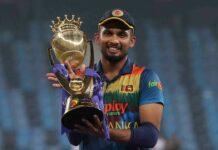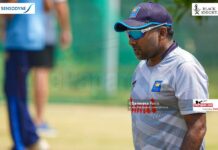The Sri Lankan doesn’t just bully weak opposition, he thrives against the best too. Enjoy him while he is still here
Rahul Dravid went first. That was in January 2012. Ricky Ponting was next, in December of that same year. Then Sachin Tendulkar, the nonpareil, in November 2012. And finally, Jacques Kallis quit the very next month. In two years, Test cricket lost its four leading scorers, and four leading century-makers. Between them they made 55,876 runs, and 173 hundreds. Put another way, these four scored 4.7% of all the centuries and 2.7% of all the runs that had been made in Test cricket till the last of them, Kallis, finally retired. All four were certain to start in the XI of their generation. Two, Kallis and Tendulkar, demand consideration for any all-time team. The landscape looks different now, it lies flatter without these four peaks.
A fifth, though, is still standing. In Chittagong earlier this month Kumar Sangakkara scored his 35th Test century, which moved him above Sunil Gavaskar and Brian Lara on the all-time list. Another, and he will pull alongside Dravid. Then only Ponting, Kallis, and Tendulkar will be ahead of him. Sangakkara had scored 319 in the first innings of that same match, his first triple century. That made him the second man in history, after Graham Gooch, to follow a score of over 300 with another over 100 in the very same game.
After it was over, Andrew Fidel Fernando wrote on Cricinfo that “outside Sri Lanka, Sangakkara is rarely spoken of in the same breath as the modern batting greats,” and “that discussion is now long overdue”. He’s right, though we shouldn’t even need the discussion – by many measures, Sangakkara’s record outstrips even those of the four men above him. And if he has been in their shadow, in their absence he should now stand on the centre of the stage.
In England at least, we have the excuse that we have never seen the best of him. His finest performance here was his coruscating Cowdrey Lecture at Lord’s. His average in England is only 30.58, and he has made just one century, at the Rose Bowl in his most recent innings here. He’s at a disadvantage in that the England and Wales Cricket Board squeezes Sri Lanka’s tours into the early part of the season, so eight of the nine Tests he has played in England – the exception is the one he got his ton in – have been started before the second week of June, when the grass is still green and the atmosphere often cold and damp.
That, though, is a bad as it gets. His record elsewhere belies the lazy assumption that he benefits from playing so many matches in Sri Lanka. In Australia, he averages 60.33, in New Zealand 66.80, in Pakistan 86.87, in the UAE, 62.
Overall, his average away from home is 51.55. He has scored centuries in every territory, with the exception of the West Indies, where, oddly, he has played only four Tests, and none at all since April 2008.
There is extra significance to that date. It was the last of the 48 Tests Sangakkara played as Sri Lanka’s wicketkeeper. In those matches he averaged 40.48. When he’s not keeping wicket, Sangakkara has played 74 Tests, scored 28 centuries, and 8,034 runs at an average of 69.86.
When compiling lists of career averages, statisticians use a minimum of 20 innings as the cut-off point. By that criterion, the only player who can top Sangakkara’s average as a specialist batsman is Don Bradman. It’s a similar leap to the one once made by Clyde Walcott, who averaged 40.36 when he was keeping wicket for West Indies, and 64.66 when he wasn’t.
Taken in its entirety, Sangakkara’s Test average of 58.07 still leaves him 10th on the all-time list, behind only the fledgling Che Pujara among modern players. No one in history has scored more runs at a higher average. He was the quickest to reach 8,000 runs, 9,000 runs, 10,000 runs – jointly, with Tendulkar and Brian Lara – and now 11,000 runs. It’s true that Sangakkara has thrived – who hasn’t? – against the weaker attacks of Zimbabwe and especially Bangladesh, who he has played against more often than most have, but strip those innings out, and his career average is still 52.68.
An intriguing piece of analysis by Kartikeya Date found that Sangakkara was “a freak of nature whose bullying of the minnows only turns a great Test record into a freakishly brilliant one.” Date devised a method of splitting Test attacks into two groups, better and worse than the median standard. Of the 11 batsmen who have scored more than 10,000 Test runs, Sangakkara was the only one to average more than 50 against the best attacks. There was only the slightest difference (0.7) between his average against the two groups. His record against the attacks when playing away from home was better still. Which is quite the contrary to what many people think.
Sangakkara’s great friend Mahela Jayawardene, on the other hand, has an average that plummets away from home, from 50.30 to 41.43 but, at his best, Jayawardene has batted with a grace, elegance, and style untouched by to any of his contemporaries other than VVS Laxman. Sangakkara’s batting was never so handsome but by the more fundamental measures of consistency, longevity, and productivity, he is as good as any. Enjoy him while he is still here because he is 36 and he too will soon be gone.























